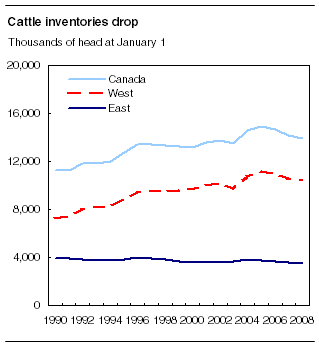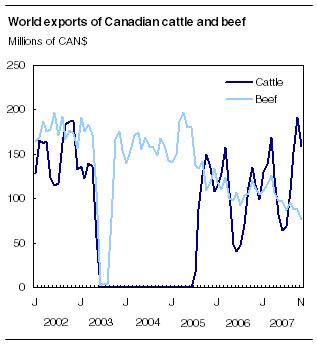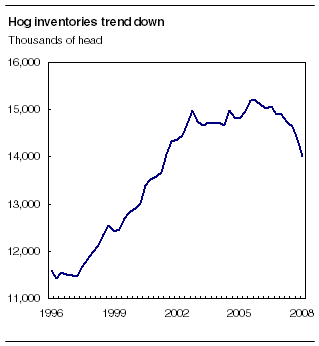Common menu bar links
Livestock estimates
Archived Content
Information identified as archived is provided for reference, research or recordkeeping purposes. It is not subject to the Government of Canada Web Standards and has not been altered or updated since it was archived. Please "contact us" to request a format other than those available.

Canada's cattle herd continued to decline during 2007, as exports to the United States accelerated. The year 2007 marked the second full year that the border has been open to Canadian cattle shipments since 2002.
As of January 1, 2008, cattlemen reported 13.9 million head on their farms, down by 210,000 head, or 1.5%, from January 1, 2007, according to the annual January Livestock Survey of 10,000 producers.
In January 2005, a record year, there were almost 1 million more cattle held on Canadian farms as closed borders forced producers to keep much of their farm stock off the market. Despite the decline, the January 1, 2008 inventory was nevertheless 479,000 head above the level as of January 1, 2003, prior to the border closure.
The US border, closed after May 20, 2003 following the disclosure of a case of bovine spongiform encephalopathy (BSE), was reopened to live cattle under 30 months of age on July 18, 2005. On November 19, 2007, it was opened to cattle born after 1999. Even with an open border, farmers continue to face different but rigorous challenges.
In general, inventories in the West rose during the early 1990s as farmers increased production in response to expanding export markets. With the closure of the US markets, thousands of cattle were held back on Canadian farms.
The Livestock Survey also showed declines in both hog and sheep inventories during the year. Hog producers indicated they had 14.0 million head as of January 1, 2008. Farmers reported 825,300 sheep on their farms, down 6.1%.
| Livestock inventories at January 1 | ||||||||
|---|---|---|---|---|---|---|---|---|
| 2007 | 2008 | 2007 | 2008 | 2007 | 2008 | |||
| Cattle | Hogs | Sheep | ||||||
| thousands of head | ||||||||
| Canada | 14,155 | 13,945 | 14,907 | 14,010 | 879 | 825 | ||
| Atlantic | 287 | 272 | 324 | 263 | 31 | 30 | ||
| Quebec | 1,365 | 1,345 | 4,174 | 3,990 | 248 | 245 | ||
| Ontario | 1,904 | 1,884 | 3,924 | 3,695 | 235 | 230 | ||
| Manitoba | 1,375 | 1,355 | 2,960 | 2,900 | 64 | 62 | ||
| Saskatchewan | 2,930 | 2,920 | 1,349 | 1,210 | 95 | 88 | ||
| Alberta | 5,680 | 5,560 | 2,045 | 1,830 | 152 | 125 | ||
| British Columbia | 615 | 610 | 131 | 122 | 54 | 45 | ||
| ||||||||

Decline in cattle largest for feeding operations
Much of the decline in the number of cattle held on farms was experienced by feeding operations, where cattle are normally finished for slaughter by being fed rations high in feed grains.
The number of cattle on feeding operations as of January 1, 2008 dropped 8.6% to 1,435,000 head. The number of cattle on cow-calf operations decreased 1% to stand at 8,581,000.
Cattle numbers fell in all beef-producing provinces, with the Western provinces accounting for almost three-quarters of the drop. The Western Canada herd combined fell by 155,000 head.
Alberta's herd, the largest of any province, declined 2.1%, while Saskatchewan's edged down and Manitoba's was off by 1.5%. In British Columbia, the herd dropped marginally. In Central Canada, Quebec's cattle count slipped 1.5%, while Ontario's was 1.1% lower.
Exports of live cattle bullish
Exports of live cattle to the United States rose rapidly once the border was reopened in July 2005. During 2007, it is estimated that exports will reach 1.4 million head, up 35% from 2006.
Despite the increase, the numbers remained well below the comparable figure of 1,688,100 animals exported in 2002, before borders were closed to live cattle shipments.

Slaughter levels have also been a key factor in the cattle business. During 2004 and the first half of 2005, levels hit record highs. They were fuelled by increased slaughter capacity, domestic demand, strong international demand for Canadian beef and lower levels of beef imports.
However, now that the border is open to live cattle and supplies in the United States have increased, levels have tapered off because of lower exports of beef meat. At 3.7 million head, slaughter in 2007 was down 6.0% from the previous 12 months.
Lower prices and higher costs pressure cattle producers
Profits for cattle producers are being squeezed between a strong Canadian dollar and high feed costs. The stronger Canadian dollar essentially exerts downward pressure on cattle prices in this country because the prices here largely follow US prices.
The weaker US dollar simply buys fewer dollars in Canada. Prices for slaughter cattle in the second half of 2007 were 5.7% below the comparable period in 2006.
At the same time, costs for feed grains have risen to challenge livestock producers. For example, barley prices in Western Canada were about 60% higher in September 2007 than they were during the same month in 2006. Meanwhile, corn prices in Ontario were up more than 50%.
Not only do higher grain prices increase the cost of feeding cattle, they also put downward pressure on the price that feedlots pay cattle producers for feeder cattle. It also doesn't help that meat packing costs are higher in Canada than in the United States, partially the result of regulations requiring the removal of risk material.
Hog industry under financial strain
Canadian hog inventories plunged during 2007 as a strong dollar and high feed costs challenged producers. According to the 2008 January Livestock Survey, there were 14.0 million hogs on farms at the first of the month, 897,000 fewer than on the same date in 2007. This is down 6.0% from 2006 and is 2.4% lower than October 1, 2007.
Prices for slaughter and export hogs, largely determined in the United States and adversely influenced by a strengthening Canadian dollar, weakened during the second half of 2007. Although variable, feed grain prices surged more than 50% in 2007.
The financial pressure on hog producers can be highlighted using a calculation that divides the hog price by a feed cost. The higher the ratio, the better the situation is for hog producers. By November 2007, the Ontario hog-corn ratio was 9.9, well down from 22.4 in 2006 and considerably lower than the 10-year average of 20.8. The hog-barley ratio in Alberta showed a similar plunge.

Farmers continued to export hogs to the United States at a record pace, reaching 9.9 million during 2007. This surpassed the previous record established in 2006. Over two-thirds of exported animals were younger hogs, called weaners, destined for feeding in the United States. At the end of 2007, with feeding costs on the increase, the weaner export market remained relatively attractive to Canadian farrowing producers.
Domestic slaughter has continued to decline after reaching a record high in 2004, consistent with soft domestic demand for pork, lower prices paid to producers and higher feeding costs. Hog slaughter dropped 2.4% between 2006 and 2007.
Available on CANSIM: tables 003-0004, 003-0026, 003-0030 to 003-0032 and 003-0083 to 003-0093.
Definitions, data sources and methods: survey number 3460.
The reports Cattle Statistics, Vol. 7, no. 1 (23-012-XWE, free), Hog Statistics, Vol. 7, no. 1 (23-010-XIE, free) and Sheep Statistics, Vol. 7, no. 1 (23-011-XIE, free) are now available online. From the Publications page of our website under Free Internet publications choose Agriculture.
For general information, contact Client Services (toll-free 1-800-465-1991). To enquire about the concepts, methods or data quality of this release, contact Robert Plourde (613-951-8716, robert.plourde@statcan.gc.ca), Agriculture Division.

